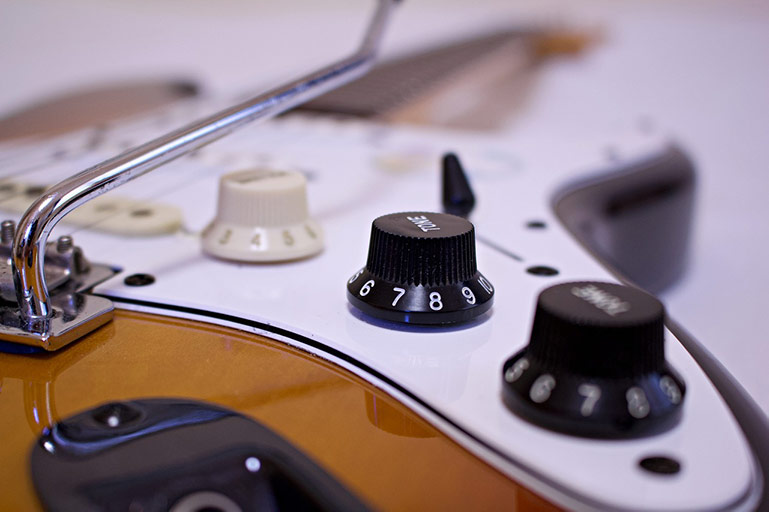Various guitar knobs and controls look a bit daunting at first sight; what are they for? How to use them? A lot of questions come to our minds.
Some guitarists neglect the controls for the most part and just let them be. If it works for them, then it’s alright. For most people, however, learning the controls is essential early in their music careers. The fact that the number of controls and how they are placed in various models and by different manufacturers also doesn’t make things easier for someone just starting out. Don’t worry! In this article, I’ll explain everything from knobs, controls and switches in detail with pictures of the most popular models and manufacturers.
You’ll find two knobs and one switch in a typical electric guitar. The “pickups selector” switch lets you select the different pickups (or a combination), which changes the tonality. Then there is a Volume knob that can adjust the signal level and a Tone knob that lets you cut off specific frequencies. The higher the Tone knob is set, the more it allows treble frequencies to pass through, making the sound brighter. On the other hand, rotating it counterclockwise results in higher range frequencies getting cut off and more bass frequencies passing through, resulting in a mellower, bass-heavy sound.
Basic Guitar Knobs and Switches
The three primary controls that can be found on most electric guitars are the following:
- Pickup Selector Switch
- Tone Knob
- Volume Knob
Most electric guitars will have more than one pickup (usually two), but some have three pickups. Depending on the number of pickups present and the model, the pickup selector could be a 3-way or 5-way selector switch.
Pickups are an essential part of the guitar as they produce sound; therefore, the guitar’s overall tone depends on them. Pickups produce an electrical signal when the strings vibrate, which is then amplified by the amp.
Even though effect pedals and amps can change the final sound output, the pickups affect the final sound output, depending on the guitar controls. The pickup selector, especially, can significantly impact the tone produced depending on which pickups you select.
The tone knob can also change the sound, but it is usually a little more subtle in this regard. Depending on your preference, you can use it to cut off certain frequency ranges, such as the high-end or low-end, making the sound either bass-heavy or treble-heavy.
The volume knob adjusts the signal’s level or magnitude and tone to some extent, especially the high-end frequencies.
Different Knob Configurations
Many guitars come with a tone, volume knob, and pickup selector switch. But, as you look through guitars from different manufacturers, you’ll find several variations of how and how many knobs are in their guitars. Some of the Ibanez and similar guitars come with a more straightforward design, while Les Paul typically has more knobs and, therefore, more control over the tone.
Let’s look at some of the standard configurations that can be found on guitars by popular manufacturers and others inspired by them.
One Tone and One Volume Knobs
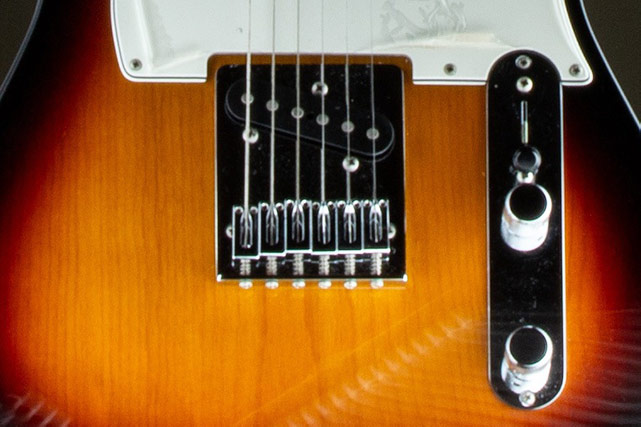
A typical design used by many manufacturers and guitars, this is the most straightforward setup where the respective knobs adjust the overall tone and volume. Many such guitars come with two pickups. The pickup selector will let you select either of the two pickups in isolation or a combination of both. Irrespective of which pickups you choose, the volume and tone controls will change the overall tone and volume of the output.
Two Tone and One Volume Knobs (Fender Strat Style)
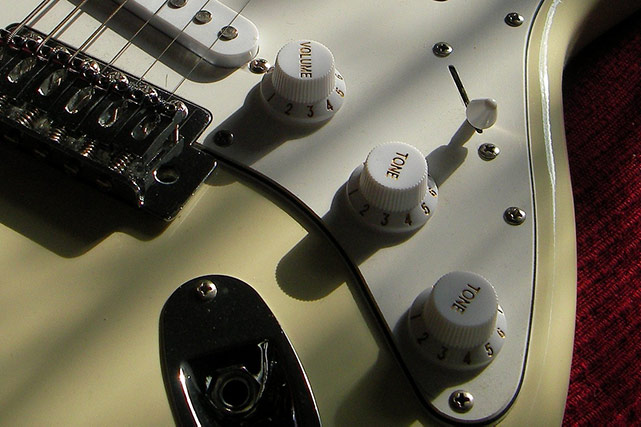
This is also a common configuration often found in Fender Strat and similar guitars. While the Fender Strat comes with three pickups, the tone knobs let you adjust the pickups’ tone separately. One tone control modifies the neck pickup’s tone, while the other does it for the middle pickup. The third (bridge) pickup has no tone controller and is preferred mainly by musicians who like a bright tone and, therefore, wouldn’t want to cut off the high-end. The one volume control knob affects the entire output together.
Most of these guitars will also have a 5-way pickup selector letting you select the neck pickup, neck and middle pickup, middle pickup, middle and bridge pickup, and bridge pickup. Some entry-level guitars may have a 3-way switch despite having three pickups and would only let you select the three pickups in isolation and never two at once.
Two Tone and Two Volume Knobs (Gibson Les Paul Style)
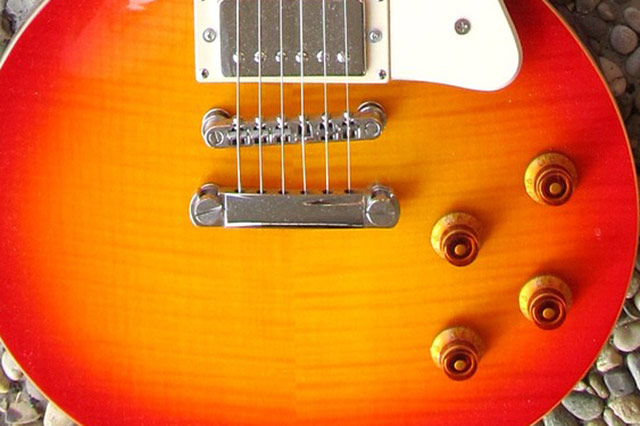
Made famous by Gibson’s Les Paul guitars, this is now known as the Les Paul design and has two tone and volume knobs. These guitars usually have two pickups and provide much flexibility in setting the tone and volume from the two pickups in isolation. One tone and one volume knob control the tone and volume of the neck pickup, while the other two knobs adjust the tone and volume for the bridge pickup.
The pickup selector, which is a 3-way switch, is marked Rhythm and Treble. The Rhythm position selects the neck pickup and provides a warm and mellow tone. The middle position selects both the pickups and provides a more natural and balanced tone, while the Treble position selects the bridge pickup and provides a treble-forward sharp and bright tone.
How to Use the Volume Knob
The volume knob is a variable resistor or pot (potentiometer) whose resistance value changes as the knob is rotated. This lets you adjust the strength of the signal passing on to the amp. The lowest resistance is the full or the highest (clockwise) rotation of the knob, where it lets most of the signal level from the pickup pass. The resistance is the highest at the lowest level, and the signal is reduced.
Not only that, but the lower position of the volume knob also reduces the treble frequencies from passing through therefore making the tone mellower. Some manufacturers use a non-linear pot with a logarithmic relation between the position of the knob and the resistance. This relation is similar to the decibel scale, which is how humans perceive the loudness of sound (a complex topic in its own right). Such pots are known to be much more accurate regarding how turning them changes the perceived volume level.
As the volume knob affects the volume and subtly the tone, you’ll have to play around with it to find the optimal setting. It is a good idea to start in the 5-7 range. If your guitar has multiple volume knobs, a lot would depend on the way you want your tone. If you want something mellow, you might want to use both the pickups or only the neck pickup and have the volume at around 5-6 for the neck pickup and 3-5 for the bridge pickup to begin. If the pots are Audio-Taper (or non-linear), you might experience a sudden increase after 6-7, so keep that in mind.
How to Use the Tone Knob
A tone knob, much like the volume knob, is also a variable resistance or a potentiometer. It is a low-pass filter that lets the low frequencies pass through and allows you to adjust how much of the high frequencies pass. Tone control can be thought of as a way to adjust the “warmth” of the tone. The lower it is set, the mellower and warmer the output will be. A higher setting that lets more treble frequencies pass through would make the sound sharp, shrilly and with less bass.
In passive guitars, the tone knob will only attenuate the different frequencies but not boost them. However, in active guitars, the tone knobs work a little differently as they can also increase the strength of specific frequencies and work more like an EQ.
The tone knob may be the most crucial insofar as changing the overall tone is concerned besides the pickup selector switch. Too low would muddy the sound, and too high might sound too shrilly. Again, like the volume knob, the tone control setting is very personal and something to play around with. You can start with a 7-8 range and adjust depending on the type of music you’re trying to play.
Your amps tone control will have a lot more effect on the overall tonality than this, but the tone knob provides a great way to fine-tune your sound. Many people don’t use it optimally or have it set at the maximum, which is like a missed chance. Play around with it and see how it can make your sound better.
Push-Pull Tone Knobs
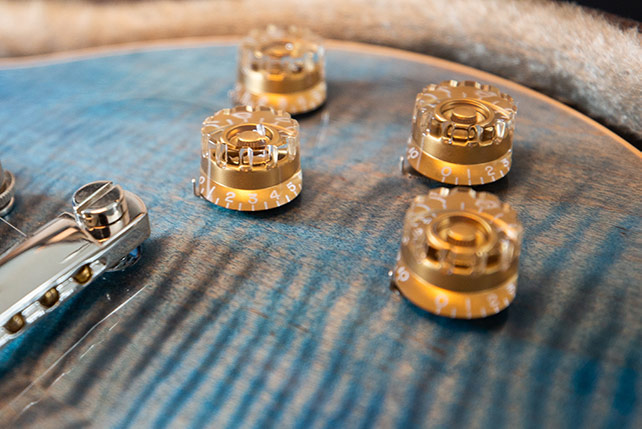
Guitars that come with humbucker pickups may have this feature where the tone and sometimes the volume knob have a push-pull switching mechanism that changes the humbucker pickups to single-coil by internally selecting a single coil (humbuckers have dual-coil inside). The “Pushed” position of the tone knob is the humbucker, while the “Pulled” position is single-coil. The dual-coil or single-coil configuration can also significantly impact the overall sound. Humbuckers provide a fuller, deeper, and warmer tone than single-coils which have a brighter and crisper tone but may have some noise or hums.
How to Use Pickup Selector Switch
Most electric guitars come with at least two pickups, and some have three. The position of the pickup affects the sound produced. Neck pickups are known to sound warm and mellow without much punch, and they might even sound muddy. The bridge pickups sound bright and treble-y with much less low end. They can start to sound too shrilly and sharp with suboptimal tone and volume settings. The middle pickup has a good balance between the two.
Sometimes, the pickup selector may be marked as having “Rhythm” and “Treble” modes. This is because the neck pickup in isolation produces cleaner tones (without much distortion) and is often used to play the rhythm part. The “Treble” mode selects the bridge pickup and, owing to the higher treble output, is generally considered better for playing lead parts, including doing solos.
Whether the guitar has two or three pickups, the switch may be a 3-way or 5-way. Let’s look at how it selects the pickups and affects the tone produced.
3-Way Selector
Most often found in guitars with two pickups, the 3-way switch lets you select the two pickups in isolation as well as having a combined mode. Position 1 would pick the neck pickup, position 2 would select both pickups, and the third position would select the bridge pickup.
In most guitars, the switch will be unmarked, and if the switch moves in the same direction as the length of the guitar, it will select the pickups in the same order. If in doubt, doing a little experiment where you play a few notes on each switch position would make it clear. The most treble-y sounding selection is the bridge pickup, and the most mellow-sounding one is the neck pickup. Some guitar models may have a 3-way selector despite having 3 pickups. In such guitars, the selector can only select each pickup in isolation.
5-Way Selector
These are found on guitars having three pickups and let you select the pickup in the following order: neck, neck-and-middle, middle, middle-and-bridge and bridge. This configuration provides much better control over the selection of the pickups being activated and, therefore, can have much better control over the final tone produced.
The pickup selector switch is one of the essential controls on the guitar. The genre and the role you have in the band would decide which pickups you want to have selected. If you have bought a new guitar, you should try out the middle position first to get the overall feel of the guitar. Then start experimenting more. If you’re the lead or want to do some solos, you might want to have the bridge or the middle-and-bridge pickup selected. You would hopefully get a good tone with some fine-tuning of the tone and volume knobs, both on the guitar and on the amp. On the other hand, if you’re playing the rhythm section, you can select the neck or the middle-and-neck pickup.
Final Thoughts
Guitar knobs or controls are often underutilized or even configured sub-optimally by many people. By their own admission, many guitarists have told me they didn’t use the knobs properly until years into their music careers, and then after learning their proper usage, they were astounded by how important they are. I hope this article can help someone seeking to learn more about what guitars knobs do, understand their use and how they can affect the overall sound.

